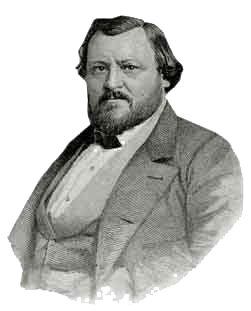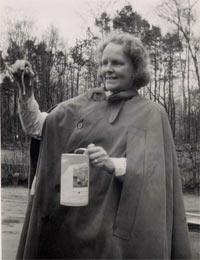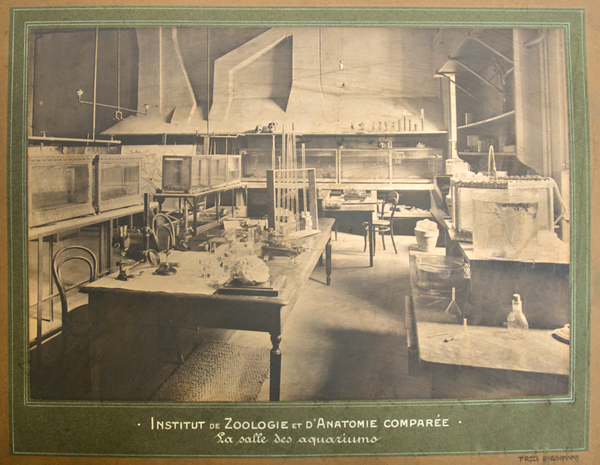The Department of Genetics and Evolution, formerly Department of Zoology and Animal Biology, is derived from the former Institute of Zoology (Comparative Anatomy, Station of Zoology, General Zoology and Endocrinology). As one of the four main initial institutes of the Faculty of Sciences, the Institute of Zoology has developed alongside the old Institute of physics (now section of physics), chemistry (now section of chemistry) and botany.
The advent and development of animal biology in Geneva was based on the ground provided by zoology and comparative anatomy. These vast and largely descriptive fields remained the core disciplines for many years, in both teaching and research. Progressively, zoology in Geneva demonstrated a pioneering role, complementing its approaches with techniques from different fields, in particular genetics. Thus, some of the current and major lines of research in our department are rooted in this historical canvas.
The pionneer: Augustin-Pyramus de Candolle
The first Chair of Zoology was awarded to Augustin-Pyramus de Candolle in 1802 as Honorary Professor. He was concomitantly appointed Professor of Botany at the Faculties of Medicine and Sciences in Montpellier. This prevented him from fulfilling his charge as Chair of Zoology, a chair that was thus attributed to Louis Jurine, Honorary Professor of Anatomy and Surgery (1802-1809) and Honorary Professor of Zoology (1809-1815).
The Honorary Chair of Zoology was converted in 1815 into an effective Chair of natural history for A.-P. de Candolle, who taught until 1835 both botany and zoology. When he retired, this task was divided into two separate Chairs, Botany and Zoology. This latter was taken by François-Jules Pictet de la Rive, who was professor of Zoology from 1835 to 1848 and Professor of Paleontology, Zoology and Comparative Anatomy from 1848 to 1872. His initial research was concerned with insects: his studies on Phryganides, Perlides and Ephemera established his reputation. On several occasions, he was replaced, for his teaching duties in the anatomy of invertebrates, either by Edouard Claparède (Honorary Professor of Zoology from 1862 to 1871), Alois Humbert (from the Museum of Natural History in 1852) or by Carl Vogt (Professor of Geology from 1853 to 1872 and of Zoology and Comparative Anatomy from 1872 to 1895)

Carl Vogt
Carl Vogt, who taught geology at the Academy for twenty years, replaced Pictet de la Rive, who died in 1872. As early as December 13 1872, the date of his appointment, Carl Vogt took over the teaching in four different fields: Geology, Paleontology, Zoology and Comparative Anatomy, which he kept until his death on May 5th 1895. Soon after his appointment, he published several comments about the anatomy of gastropods, as well as articles concerning Siphonophora and pelagic tunicates of the Sea of Nice etc…

From 1878 to 1886, the teaching of zoology was complemented and enriched by a regular Chair of Embryology and Teratology, which was awarded to Prof. Hermann Fol from 1878 to 1885. Prof. Fol was also, from 1885 to 1892, Professor of General Morphology including comparative microscopic anatomy and medical zoology. When he resigned, the Chair was transferred to the Faculty of Medicine and attached to the Chair of Normal Histology.
In 1880, Emile Yung, a former assistant of Carl Vogt and a privat-docent since 1879, published in collaboration with Carl Vogt, a "Traité d'anatomie comparée pratique". His research was in the field of experimental physiology. In 1883, he was awarded an extraordinary Chair in General Zoology, which he occupied until 1895. He gave lectures on the evolutionary theory of the ‘organic kingdom’, on anthropology, and on the mental faculties of animals. In 1895 he succeeded to Carl Vogt as Professor of Zoology and Comparative Anatomy. On December 7th 1895, Prof. Maurice Bedot, director of the Museum of Natural History and founder of the Swiss Journal of Zoology, replaced Emile Yung as extraordinary Chair of General Zoology. In 1913, this Chair was entrusted to Prof. Emile André who was then instructed to teach general zoology and animal parasitism two hours per week.
On November 1st 1918, two nominations took place: the first one was for Prof. E. André, who taught in protistology, parasitology and lake zoology. The second nomination was concerned with zoology and comparative anatomy, and the University and the State of Geneva Council directly appointed Emile Guyénot, a winner of the Longchamp prize of the French Academy of Sciences for his research in biology.
A push toward experimentation: Emile Guyénot
The new Chair oriented his teaching towards general biology. Courses of the winter semester were on general zoology (cell, tissue, oogenesis, spermatogenesis, fertilization, parthenogenesis) and human parasites, whereas the summer semester remained devoted to the anatomy of vertebrates. Teaching was modified to integrate modern concepts of evolution. One hour of course was devoted to a question of general biology, dealing with various issues such as transmutation, heredity, variation, sex determination or developmental physiology). Since students had very old microscopes for practical works, a special credit was given to purchase numerous ‘modern’ instruments.

When Emile Guyénot accepted the Chair of General Zoology at the University of Geneva, he was determined to make it a renown center for experimental biology. He would never have reached this goal without the substantial help, in 1923, of a large donation by Georges and Antoine Claraz. Once the first station of experimental zoology was established in 1922, Emile Guyénot introduced practical exercises in genetics (in winter) and experimental biological techniques (in summer). During these exercises, the students learned the bases of the laws of heredity (monohybrid, dihybrid, trihybrid, sex-linked inheritance, linkage, crossing over). They were also taught aseptic surgery on anesthetized animals. In 1933, significant support from the Rockefeller Foundation enabled the construction of a new experimental station of zoology, on a land donated to the University of Geneva by the Academic Society, at the route de Malagnou.

Emile Guyénot revolutionized the teaching of zoology in Geneva and adapted it to both physicians and biologists. He addressed several lines of research, but it is in the field of regeneration that he most importantly developed his ideas by demonstrating in adults and in embryos, the presence of ‘organoformatives’ territories, a fruitful concept that was subsequently extended to many other fields. He was also interested in the study of sexuality and intersexuality of batracians, in lampbrush chromosomes of amphibians, and in the genetics and cytogenetics of Drosophila. He looked at the effects of UV and X rays on gonocytes (embryonic castration) and on the mutability of Drosophila, as well as the endocrinology of gonadotropin hormones, TSH and pituitary corticotrophs.

In 1942, Kitty Ponse was appointed as "Chargé de cours". She had participated for many years to the practical courses taught at the station of experimental zoology and had also actively collaborated to research in the field of endocrinology. She was nominated, as professor, in the chair of experimental endocrinology in 1961.
The same year (1961), Michael Fischberg was appointed Professor and, as the successor of E. Guyénot, took the direction of the Station of Zoology and of the Laboratory of General Zoology. After the retirement of E. Guyénot, three laboratories remained active:
- The laboratory of Developmental Biology and Genetics, located both in the Station of Zoology and in the main University building, lead by Professors M. Fischberg and A. Blackler
- The laboratory of Endocrinology, located in a new building near the Station of Zoology, with Prof. K. Ponse
- The laboratory of Comparative Anatomy and Physiology, located in the main building of the University, with Prof. Hansjörg Huggel, appointed professor in 1969

Prof. Blackler left the University of Geneva in 1964. This departure was followed by the appointments of Professors Gerard de Haller in Protistology (1969), Hans Gloor in Genetics (1970), and Marc Crippa for Molecular Embryology (1971).
With the appointment of Karl Illmensee (1977), the department was strengthened in the field of vertebrate embryology, especially mammals, as well as in the biology of neuropeptides, when Prof. Michael O'Shea was called (1984). Further expertise was gained in animal systematics with the appointment of Prof. Louisette Zanninetti (1984).
Modern times
After the premature departures of professors Crippa (1984), O'Shea (1988) and Illmensee (1987), the Section of Biology of the University went through a major reorganization, including the transfer of two vacant Chairs to create a new Department of Cell Biology. At the same time, the construction of a new building for biology started on the bank of the Arve river, near the school of Physics. This building, Sciences III, was intended to consolidate the entire section of Biology of the Faculty of Sciences at the same geographical site.
It is Prof. Pierre Spierer, appointed in 1990, a specialist in molecular genetics of the fruit fly Drosophila, who took the leadership of the Department in 1991 and of the Section of Biology in 1992. Under his direction, the Department moved into the new Sciences III building. From this time-point, the Department strengthened the field of animal developmental genetics, first via the appointments of Prof. Vincenzo Pirrotta in 1992, an expert in Drosophila genetics, and then of Prof. Denis Duboule, a specialist in developmental genetics of mammals in 1992. Prof. Pirrotta took over as Head of Department from 1992 to 1998 and retired early in 2004. The Department was chaired by Professor Denis Duboule from 1997 to July 2017, and then by Professor Ivan Rodriguez.
In 2001, the Swiss Confederation created in Geneva The National Centre of Competence in Research (NCCR) 'Frontiers in Genetics', as a result of a national competition. This program, evaluated and selected by international experts, provided substantial funding for 12 years before being taken over by the University. It included the creation of services, primarily in genomics, microscopy and animal platforms, the establishment of a national graduate school and a strong support to collaborative research projects. Professors Duboule, Karch, Pirrotta, Rodriguez and Spierer, from the department, were or currently are members of this program. The leadership and administration of this operation are located within the department, thus re-enforcing the visibility of our activities and of Geneva as a centre for genetics.
The construction of the Sciences III building was achieved in 2003, and the whole department (then of ‘Zoology and Animal Biology’) could finally locate at one and the same place, together with three other departments of the Section of Biology.

In 2006, the station of experimental zoology in Malagnou, which was led since 1996 by Prof. Duri Rungger, closed operations. 73 years after the construction of this building, one of the major pages in the history of biological sciences in Geneva turned. The premises were definitely abandoned by the department in 2010. In 2012, professor Pierre Spierer retired, after having served as President of the Biology section, then as Dean of the Faculty of Sciences (2004-2007) and eventually, as a vice-Rector of the University (2008-2011).
Birth of a new department: GenEv
Between 2005 and 2010, the department has substantially strengthened its competences in the fields of genetics and evolution at large, in particular through several recruitments. This decision to invest into these two fields of research, the importance of which is not restricted to sciences in itself, lead to the change in the name of our department in order to better materialize and advertize our competences and fields of interests. We will of course continue to teach fundamental disciplines such as zoology and systematics, in particular thanks to the convention we hold with our colleagues from the museum of Natural History from the City of Geneva.
In 2011, the new Department of Genetics & Evolution was born. In 2011 too, following an internal reorganization of the former department of Anthropology, the Anthropology Unit (UA) joined our department, thus widening its realm of competences and teaching capacities.
The department of Genetics and Evolution currently includes the research operations of Professors Brigitte Galliot, Michel Milinkovitch, Ivan Rodriguez, Alessandro De Simone, Emi Nagoshi and Alicia Sanchez-Mazas, as well as those of Drs Daniel Pauli, Estella Poloni and Mathias Currat.
